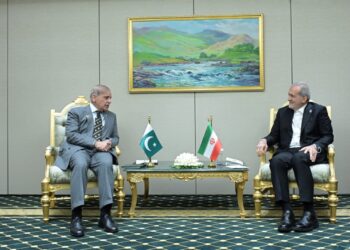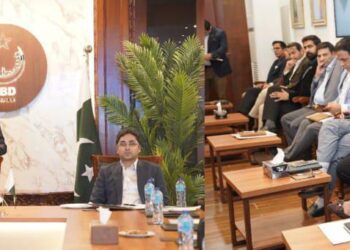Written by Dr. Rehan Rasheed Tanoli
In today’s Pakistan, a pixel is no longer just a dot on a screen; it is a weapon, a witness, and a whisper in the vast chorus of digital narratives. From memes that lampoon political figures to TikTok clips that spark civic discourse, Pakistan’s digital landscape has become a shifting terrain of stories; crafted, distorted, amplified, and suppressed.
This piece examines how narrative building and amplification are transforming online ecosystems in Pakistan, and how a structured media and information literacy program, integrated into the education system, offers a meaningful, evidence-informed response to these challenges.
Narratives are no longer spun through long manifestos but built frame by frame. A protest snapshot in Gwadar, a blurred clip of a political aide being detained, or a meme likening one leader to a lion and another to a tiger, these pixel fragments carry powerful symbols that resonate emotionally and ideologically. Digital platforms like X, TikTok, and YouTube serve as dynamic canvases for such visual storytelling. As scholars such as Hassan Khali have observed, these platforms enable actors “to disseminate their narratives, mobilize supporters, and cultivate fear and selfcensorship”
Narrative construction in Pakistan is often strategically engineered. Political parties deploy digital squads, sometimes leveraging bots or inauthentic accounts, to amplify narratives or delegitimize opponents. The PTI’s rise, for instance, was not only a result of political messaging but also a careful curation of memes, catchy hashtags, and influencer content, visual building blocks packaged for virality. The PMLN, in turn, cultivated its own counter-narrative emphasizing electoral legitimacy and stability, shared via Facebook and YouTube influencers.
This digital arms race is not without cost. As Babar Farooq; Nazia Malik, AND Saira Siddiqui noted in a paper that, “the use of bots and fake accounts to amplify narratives and suppress dissent” has fueled polarisation and eroded trust in digital platforms.
Algorithmic amplification compounds the problem. Platforms reward provocative content, outrage and drama generate engagement. Muhammad Yaseen Moroojo explains that “algorithmic systems amplify certain political narratives while suppressing others,” reinforcing echo chambers and favoring traction over truth.
During periods of political transition, such as the 2022, a flood of viral content depicting institutions in contentious ways blurred facts and emotions in the public discourse. Emotional captions and visuals created powerful narratives, not always grounded in accuracy.
Digital provocation, once confined to late-night satire or print cartoons, is now instantaneous and widespread. Satirical accounts often use humor to critique prevailing narratives, but the lines blur when misattributed or manipulated content circulates unchecked, like mislabelled videos or AI-generated audio fabricated to appear real. One such clip, allegedly capturing a dialogue between a high-profile politician and a judge, went viral before being questioned for authenticity. The transient confusion it sowed reveals the fragility of trust in our media systems. “The hidden cost of digital propaganda,” as Brig (R) Dr. Zeeshan Faisal Khan notes, “is the erosion of social cohesion,” especially when such provocations are orchestrated.
In Pakistan, the struggle over narratives doesn’t end at digital amplification, it extends to suppression. The Pakistan Telecommunication Authority (PTA) has, at times, blocked access to platforms like TikTok, X, and YouTube, invoking legal, moral, or security reasons. These measures can stifle voices from underrepresented and remote regions. For instance, Baloch activists raising awareness about human rights issues have reported content restrictions or removals, as documented by Muhammad Salman Ijaz in his article, limiting their ability to project alternative narratives.
Censorship doesn’t just silence, it reshapes perceived reality by privileging curated viewpoints. In a society where democratic structures are evolving, this effect is markedly serious.
Information warfare in Pakistan increasingly involves sophisticated tools. Fake news farms, bot networks promoting curated agendas, and influencers paid to push selective narratives. Muhammad Noaman Yousaf argued in “Combating Fake News and Propaganda: Policy Approaches for Safeguarding Media Integrity and Public Trust in Pakistan” that safeguarding media integrity and public trust must underlie any effective response.
Cross-border dynamics further complicate matters: Saudi & Kazim document how campaigns originating from across the border have aimed to distort perceptions about Pakistan. Domestic responses then perpetuate a cycle of digital escalation.
Amid this complexity, Mediatiz Foundation’s Media Mind program brings a beacon of practical and timely intervention. Designed as Pakistan’s first online media literacy and civic learning curriculum, Media Mind aims to arm youth with the knowledge and skills to critically navigate media content. It blends UNESCO-aligned media and information literacy principles with local realities, helping learners discern bias, understand misinformation, and engage ethically online. Its modules range from foundational digital literacy (grades 5–8) to advanced media analysis and misinformation countermeasures (grades 11–12 and tertiary).
Media Mind’s layered approach does several things:
- It strengthens critical thinking, enabling students to question headline claims, identify emotional manipulation, and detect doctored images.
- It elevates digital citizenship, teaching principles of respectful dialogue and online ethics, teaching learners not just what to think, but how to think.
- It builds resilience against misinformation, helping students to pause before sharing sensational clips or viral content, and to analyze authenticity.
- It develops inclusive civic agency, especially among younger demographics, empowering them to contribute positively rather than be unwitting amplifiers of propaganda.
In randomized educational trials in Pakistan, tailored media literacy interventions especially those providing personalized feedback on past engagement, have been shown to significantly improve individuals’ ability to detect fake news. Mediatiz’s model aligns well with such evidence, reinforcing the importance of trusted, curriculum-based approaches.
Thus, while Media Mind may not eliminate propaganda engines or algorithmic biases overnight, it builds foundational safeguards, empowering citizens with discernment and digital resilience. Alongside broader policy measures, such as platform accountability, responsive regulation, and inclusive narrative spaces, Media Mind represents a critical and constructive response.
In a society where pixels shape perception, controlling the image often means shaping the story. Mediatiz’s literacy intervention doesn’t claim to rewrite every narrative, but it equips citizens to read between the pixels, and to add their voice thoughtfully, not reactively. Next time you scroll before resharing, pause to ask: What am I amplifying? Why does this move me? Who benefits and who is silent?






















